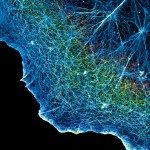Link to DOI – https://doi.org/10.1038/ s43586-021-00038-x
1 (1), 1-27
[embeddoc url=”https://research.pasteur.fr/wp-content/uploads/2021/06/research_pasteur-single-molecule-localization-microscopy-s43586-021-00038-x-1.pdf” download=”all” viewer=”google” cache=”off”]
Single-molecule localization microscopy (SMLM) describes a family of powerful imaging
techniques that dramatically improve spatial resolution over standard, diffraction-limited
microscopy techniques and can image biological structures at the molecular scale. In SMLM,
individual fluorescent molecules are computationally localized from diffraction-limited image
sequences and the localizations are used to generate a super-resolution image or a time course
of super-resolution images, or to define molecular trajectories. In this Primer, we introduce the
basic principles of SMLM techniques before describing the main experimental considerations
when performing SMLM, including fluorescent labelling, sample preparation, hardware
requirements and image acquisition in fixed and live cells. We then explain how low-resolution
image sequences are computationally processed to reconstruct super-resolution images and/or
extract quantitative information, and highlight a selection of biological discoveries enabled by
SMLM and closely related methods. We discuss some of the main limitations and potential
artefacts of SMLM, as well as ways to alleviate them. Finally, we present an outlook on advanced
techniques and promising new developments in the fast-evolving field of SMLM. We hope that
this Primer will be a useful reference for both newcomers and practitioners of SMLM


